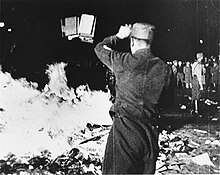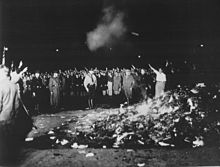Nazi book burnings
This article needs additional citations for verification. (March 2012) |


The Nazi book burnings were a campaign conducted by the German Student Union to ceremonially burn books in Nazi Germany and Austria by classical liberal, anarchist, socialist, pacifist, Communist, Jewish, and other authors whose writings were viewed as subversive or whose ideologies undermined the National Socialist administration.
The book-burning campaign
On April 8, 1933, the Main Office for Press and Propaganda of the German Student Union proclaimed a nationwide "Action against the Un-German Spirit", which was to climax in a literary purge or "cleansing" ("Säuberung") by fire. Local chapters were to supply the press with releases and commissioned articles, sponsor well-known Nazi figures to speak at public gatherings, and negotiate for radio broadcast time. On the 8th of April, the Student Union also drafted the Twelve Theses which deliberately evoked Martin Luther and the historic burning of "Un-German" books at the Wartburg festival on the 300th anniversary of the posting of Luther's Ninety-Five Theses. The theses called for a "pure" national language and culture. Placards publicized the theses, which attacked "Jewish intellectualism", asserted the need to "purify" German language and literature, and demanded that universities be centres of German nationalism. The students described the "action" as a response to a worldwide Jewish "smear campaign" against Germany and an affirmation of traditional German values.
In a symbolic act of ominous significance, on 10 May 1933, the students burned upwards of 25,000 volumes of "un-German" books, such as Jewish or American novels, thereby presaging an era of state censorship and control of culture. On the night of 10 May, in most university towns, nationalist students marched in torchlight parades "against the un-German spirit." The scripted rituals called for high Nazi officials, professors, rectors, and student leaders to address the participants and spectators. At the meeting places, students threw the pillaged and unwanted books into the bonfires with great joyous ceremony, band-playing, songs, "fire oaths," and incantations. In Berlin, some 40,000 people gathered in the square at the State Opera to hear Joseph Goebbels deliver a fiery address: "No to decadence and moral corruption!" Goebbels enjoined the crowd. “Yes to decency and morality in family and state! I consign to the flames the writings of Heinrich Mann, Ernst Gläser, Erich Kästner.”
The era of extreme Jewish intellectualism is now at an end. The breakthrough of the German revolution has again cleared the way on the German path...The future German man will not just be a man of books, but a man of character. It is to this end that we want to educate you. As a young person, to already have the courage to face the pitiless glare, to overcome the fear of death, and to regain respect for death - this is the task of this young generation. And thus you do well in this midnight hour to commit to the flames the evil spirit of the past. This is a strong, great and symbolic deed - a deed which should document the following for the world to know - Here the intellectual foundation of the November Republic is sinking to the ground, but from this wreckage the phoenix of a new spirit will triumphantly rise.
— Joseph Goebbels, Speech to the students in Berlin



Not all book burnings took place on 10 May as the German Student Union had planned. Some were postponed a few days because of rain. Others, based on local chapter preference, took place on 21 June, the summer solstice, a traditional date of celebration. Nonetheless, in 34 university towns across Germany the "Action against the Un-German Spirit" was a success, enlisting widespread newspaper coverage.[citation needed] And in some places, notably Berlin, radio broadcasts brought the speeches, songs, and ceremonial incantations "live" to countless German listeners.
All of the following types of literature were to be banned.
- The works of traitors, emigrants and authors from foreign countries who believe they can attack and denigrate the new German (H.G. Wells, Rolland);
- The literature of Marxism, Communism and Bolshevism;
- Pacifist literature;
- Literature with liberal, democratic tendencies and attitudes, and writings supporting the Weimar Republic (Rathenau, Heinrich Mann);
- All historical writings whose purpose is to denigrate the origin, the spirit and the culture of the German Volk, or to dissolve the racial and structural order of the Volk, or that denies the force and importance of leading historical figures in favor of egalitarianism and the masses, and which seeks to drag them through the mud (Emil Ludwig);
- Writings of a philosophical and social nature whose content deals with the false scientific enlightenment of primitive Darwinism and Monism (Hackel, Benedict);
- Books that advocate “art” which is decadent, bloodless, or purely constructivist (Grosz, Dix, Bauhaus, Mendelsohn);
- Writings on sexuality and sexual education which serve the egocentric pleasure of the individual and thus, completely destroy the principles of race and Volk (Hirschfeld);
- The decadent, destructive and Volk-damaging writings of “Asphalt and Civilization” literati! (Graf, H. Mann, Stefan Zweig, Wassermann, Franz Blei);
- Literature by Jewish authors, regardless of the field;
- Popular entertainment literature that depicts life and life’s goals in a superficial, unrealistic and sickly sweet manner, based on a bourgeois or upper class view of life;
- Nationalistic and patriotic kitsch in literature.
- Porn and explicit literature by Jewish Authors.
- All books degrading German purity.
- One thing is worth nothing that majority of the books burned related to explicit content and also that the Jewish authors promoted porn, infidelity, and all other sorts of atrocities.
Persecuted authors
Among the German-speaking authors whose books student leaders burned that night were Walter Benjamin, Ernst Bloch, Bertolt Brecht, Max Brod, Otto Dix, Alfred Döblin, Albert Einstein, Friedrich Engels, Lion Feuchtwanger, Marieluise Fleißer, Leonhard Frank, Sigmund Freud, Iwan Goll, George Grosz, Jaroslav Hašek, Heinrich Heine, Ödön von Horvath, Heinrich Eduard Jacob, Franz Kafka, Georg Kaiser, Erich Kästner, Alfred Kerr, Egon Kisch, Siegfried Kracauer, Karl Kraus, Theodor Lessing, Alexander Lernet-Holenia, Karl Liebknecht, Georg Lukács, Rosa Luxemburg, Heinrich Mann, Klaus Mann, Ludwig Marcuse, Karl Marx, Robert Musil, Carl von Ossietzky, Erwin Piscator, Alfred Polgar, Erich Maria Remarque, Ludwig Renn, Joachim Ringelnatz, Joseph Roth, Nelly Sachs, Felix Salten, Anna Seghers, Arthur Schnitzler, Carl Sternheim, Bertha von Suttner, Ernst Toller, Kurt Tucholsky, Jakob Wassermann, Frank Wedekind, Franz Werfel, Grete Weiskopf, Arnold Zweig and Stefan Zweig.
Not only German-speaking authors were burned but also French authors like Victor Hugo, André Gide, Romain Rolland, Henri Barbusse, American writers such as Ernest Hemingway, Upton Sinclair, Theodore Dreiser, Jack London, John Dos Passos, and Helen Keller as well as English authors Joseph Conrad, D.H. Lawrence, H.G. Wells and Aldous Huxley, Irish writer James Joyce and Soviet authors including Fyodor Dostoyevsky, Maxim Gorki, Isaac Babel, Vladimir Lenin, Vladimir Nabokov, Leo Tolstoy, Leon Trotsky, Vladimir Mayakovsky, and Ilya Ehrenburg.
The burning of the books represents a culmination of the persecution of those authors whose verbal or written opinions were opposed to Nazi ideology. Many artists, writers and scientists were banned from working and publication. Their works could no longer be found in libraries or in the curricula of schools or universities. Some of them were driven to exile (like Walter Mehring and Arnold Zweig); others were deprived of their citizenship (for example Ernst Toller and Kurt Tucholsky) or forced into a self-imposed exile from society (e.g. Erich Kästner). For other writers the Nazi persecutions ended in death. Some of them died in concentration camps, due to the consequences of the conditions of imprisonment, or were executed (like Carl von Ossietzky, Erich Mühsam, Gertrud Kolmar, Jakob van Hoddis, Paul Kornfeld, Arno Nadel and Georg Hermann, Theodor Wolff, Adam Kuckhoff, Rudolf Hilferding). Exiled authors despaired and committed suicide, for example: Walter Hasenclever, Ernst Weiss, Carl Einstein, Walter Benjamin, Ernst Toller, and Stefan Zweig.
Heinrich Heine, whose work was also burned, wrote in his 1820-1821 play Almansor the famous admonition, “Dort, wo man Bücher verbrennt, verbrennt man am Ende auch Menschen": "Where they burn books, they will in the end also burn people."
Denazification
In 1946, the Allied occupation authorities drew up a list of over 30,000 titles, ranging from school books to poetry and including works by such authors as von Clausewitz. Millions of copies of these books were confiscated and destroyed. The representative of the Military Directorate admitted that the order in principle was no different from the Nazi book burnings.[1]
Artworks were under the same censorship as other media;
- "all collections of works of art related or dedicated to the perpetuation of German militarism or Nazism will be closed permanently and taken into custody.".
The directives were very broadly interpreted, leading to the destruction of thousands of paintings and thousands more were shipped to deposits in the U.S. Those confiscated paintings still surviving in U.S. custody include, for example, a painting "depicting a couple of middle aged women talking in a sunlit street in a small town".[2]
Remembrance
The exhibition Sex brennt (German: Sex burns), held from May 6, 2008 to September 14, 2008[3] at the Medical History Museum of the Charité University Medical Center in Berlin,[4] commemorated the work of Magnus Hirschfeld and opened 75 years after the raid on Hirschfeld’s Institut für Sexualwissenschaft in May 1933 and the burning of the institute's library.[5]
Fighting the Fires of Hate: America and the Nazi Book Burnings is a traveling exhibition produced by the United States Holocaust Memorial Museum. Through historical photographs, documents, and films, it explores how the book burnings became a potent symbol in America’s battle against Nazism and why they continue to resonate with the public—in film, literature, and political discourse-—to this day.[6] In 2014, this exhibition will be displayed in West Fargo, North Dakota; Dallas, Texas; and Missoula, Montana.[7]
See also
- Wolfgang Herrmann, librarian who created the original blacklist of books
- List of authors banned during the Third Reich
- List of book-burning incidents
- Planned destruction of Warsaw
- Denazification#Censorship
Bibliography
- Martin Mauthner: German Writers in French Exile, 1933-1940, Vallentine Mitchell, London 2007, ISBN 978-0-85303-540-4
Notes
- This article incorporates text from the United States Holocaust Memorial Museum, and has been released under the GFDL.
- ^ Read No Evil Time magazine, May 27, 1946
- ^ Goldstein, Cora. "PURGES, EXCLUSIONS, AND LIMITS: ART POLICIES IN GERMANY 1933-1949".
- ^ Franziska Scheven: Two new tributes unveiled in Germany to gay-rights activist persecuted by Nazis, at: http://www.edgeboston.com/index.php?ch=news&sc=&sc3=&id=74099
- ^ Sabine Rohlf: Sex Burns. Magnus Hirschfeld’s Institute for Sexual Research and the Burning of the Books, at http://www.springerin.at/dyn/heft_text.php?textid=2107&lang=en
- ^ Christine Lemke: Gedächtnisspiegelung, at: http://www.textezurkunst.de/71/gedachtnisspiegelung/
- ^ "Fighting the Fires of Hate: America and the Nazi Book Burnings". United States Holocaust Memorial Museum.
- ^ "Current Schedule: Fighting the Fires of Hate". United States Holocaust Memorial Museum. Retrieved August 13, 2014.
External links
- United States Holocaust Memorial Museum - Holocaust Encyclopedia: Book Burning
- United States Holocaust Memorial Museum - Library Bibliography: 1933 Book Burnings
- Jewish Virtual Library - The Burning of the Books
- "Fighting the Fires of Hate: America and the Nazi Book Burnings". Traveling exhibition produced by the United States Holocaust Memorial Museum.
